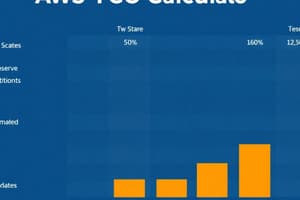Podcast
Questions and Answers
What is the primary focus of cloud cost analysis?
What is the primary focus of cloud cost analysis?
- The process of designing cloud computing infrastructure.
- Implementing complex cybersecurity measures.
- Establishing new strategic objectives for a business.
- Identifying, understanding, and tracking expenses related to cloud computing and its infrastructure. (correct)
Which of the following contributes most to cost efficiency in cloud usage?
Which of the following contributes most to cost efficiency in cloud usage?
- Enhancing the data retrieval frequency.
- Implementing measures to curb overspending by identifying areas of high expenditure. (correct)
- Increasing the redundancy options.
- Establishing strategic objectives.
What does improved transparency in cloud cost analysis offer?
What does improved transparency in cloud cost analysis offer?
- Lower resource utilization.
- Reduced strategic objections.
- Higher cloud expenses.
- Deeper insight into cloud expenses. (correct)
What is the relationship between cloud cost analysis and cloud cost optimization?
What is the relationship between cloud cost analysis and cloud cost optimization?
Which of the following is NOT a key infrastructural element that needs to be factored into cloud cost analysis?
Which of the following is NOT a key infrastructural element that needs to be factored into cloud cost analysis?
What is the primary component of infrastructure costs in cloud cost analysis?
What is the primary component of infrastructure costs in cloud cost analysis?
What methods can you use to minimize infrastructure costs?
What methods can you use to minimize infrastructure costs?
What factors should businesses consider when estimating infrastructure costs?
What factors should businesses consider when estimating infrastructure costs?
What is the main concern regarding data transfer in the context of cloud cost analysis?
What is the main concern regarding data transfer in the context of cloud cost analysis?
What strategies can organizations use to reduce expenses related to data transfer fees?
What strategies can organizations use to reduce expenses related to data transfer fees?
How do cloud-deployed software and third-party services contribute to licensing expenses?
How do cloud-deployed software and third-party services contribute to licensing expenses?
What should one analyze to understand licensing costs?
What should one analyze to understand licensing costs?
What is the primary concern regarding storage costs in cloud cost analysis?
What is the primary concern regarding storage costs in cloud cost analysis?
What reduces overall storage costs?
What reduces overall storage costs?
Aside from infrastructure, support, and maintenance fees, what additional costs are associated with cloud computing?
Aside from infrastructure, support, and maintenance fees, what additional costs are associated with cloud computing?
What is the initial step in calculating cloud computing costs?
What is the initial step in calculating cloud computing costs?
Why is selecting the most appropriate cloud service model so important?
Why is selecting the most appropriate cloud service model so important?
What is the primary focus when determining resource requirements for cloud workloads?
What is the primary focus when determining resource requirements for cloud workloads?
What is the key characteristic of the pay-as-you-go pricing model offered by most cloud providers?
What is the key characteristic of the pay-as-you-go pricing model offered by most cloud providers?
How can cloud providers pricing tools and online calculators assist in calculating cloud computing costs?
How can cloud providers pricing tools and online calculators assist in calculating cloud computing costs?
What is the purpose of analyzing the Total Cost of Ownership (TCO) when calculating cloud computing costs?
What is the purpose of analyzing the Total Cost of Ownership (TCO) when calculating cloud computing costs?
What benefits does public cloud provide in general?
What benefits does public cloud provide in general?
What are the advantages of cloud cost analysis?
What are the advantages of cloud cost analysis?
What variables affect storage expenses?
What variables affect storage expenses?
What are the benefits of applying cloud cost analysis to a company?
What are the benefits of applying cloud cost analysis to a company?
Flashcards
Cloud Cost Analysis
Cloud Cost Analysis
Identifying, understanding, and tracking costs related to cloud computing and IT infrastructure.
Importance of Cloud Cost Analysis
Importance of Cloud Cost Analysis
Aligning cloud usage with strategic objectives and understanding resource consumption.
Improved Transparency
Improved Transparency
Offers clear insight into cloud expenses and resource utilization understanding.
Cost Efficiency
Cost Efficiency
Implementing measures to reduce overspending, which helps in optimizing cloud usage.
Signup and view all the flashcards
Effective Budgeting and Forecasting
Effective Budgeting and Forecasting
Cloud cost analysis facilitates understanding of current usage patterns for planning.
Signup and view all the flashcards
Waste Reduction
Waste Reduction
Spotting underutilized resources.
Signup and view all the flashcards
Informed Decision-Making
Informed Decision-Making
Cloud cost analysis offers data-driven insights for resource allocation.
Signup and view all the flashcards
Cloud Cost Optimization
Cloud Cost Optimization
Cloud cost optimization works on reducing cloud costs.
Signup and view all the flashcards
Key Components of Cloud Cost Analysis
Key Components of Cloud Cost Analysis
Compute, Networking, Storage and licensing.
Signup and view all the flashcards
Infrastructure Costs
Infrastructure Costs
Include costs related to computer resources, virtual machines, and containers.
Signup and view all the flashcards
Data Transfer Cost
Data Transfer Cost
Moving data between resources/frameworks.
Signup and view all the flashcards
Licensing Cost
Licensing Cost
Paying to install software.
Signup and view all the flashcards
Storage Cost
Storage Cost
Costs of distribution and maintenance of data among cloud storage services.
Signup and view all the flashcards
Additional Costs
Additional Costs
Cover serverless computing, machine learning, and managed services.
Signup and view all the flashcards
Define Requirements
Define Requirements
Have understanding of cloud migration needs.
Signup and view all the flashcards
Select The Right Service Model
Select The Right Service Model
Choosing model that fits financial needs.
Signup and view all the flashcards
Resource Requirements
Resource Requirements
Determine the resources required to serve cloud workloads.
Signup and view all the flashcards
Pricing Models
Pricing Models
Provides a pay-as-you-go approach.
Signup and view all the flashcards
Calculate Usage Cost
Calculate Usage Cost
Use pricing tools to determine expenses.
Signup and view all the flashcards
Total Cost of Ownership
Total Cost of Ownership
Analyze the total cost of running workloads.
Signup and view all the flashcardsStudy Notes
- Course Title: Cloud Cost Analysis
- Course Code: ITCL 205
- Credit hours: 2
- Contact hours: 42
- Program: Cloud Computing
- Course Level: 3
- Course Description: The course covers the fundamentals of cloud Cost Analysis.
Introduction to Cloud Cost Analysis
- Cloud computing, especially public cloud, provides scalability, flexibility, and greater innovation opportunities compared to on-premises frameworks.
- Cloud cost analysis helps identify key areas costing the most money and optimize them.
- It also helps understand spending on various cloud services.
Cloud Cost Analysis
- Cloud cost analysis identifies, understands, and tracks costs related to cloud computing and IT Infrastructure.
- Businesses can reduce costs, optimize cloud use, and invest their budget effectively by performing cloud cost analysis.
- It evaluates expenses of using cloud computing services.
- Organizations are charged for computing resources like storage, processing power, and network bandwidth when they use cloud services.
- Costs can rapidly increase if usage is not carefully managed.
Importance of Cloud Cost Analysis
- Aligning a business's cloud usage with strategic objectives is crucial and is aided by cloud cost analysis.
- It provides a detailed picture of cloud expenditures relative to organizational goals.
- Improved Transparency: Offers insight into cloud expenses for a comprehensive understanding of resource utilization.
- Cost Efficiency: Businesses can identify and implement measures to reduce overspending, optimizing cloud usage.
- Effective Budgeting and Forecasting: Cloud cost analysis facilitates understanding of current usage patterns, enabling businesses to effectively plan and forecast future cloud expenses.
- Waste Reduction: It aids in spotting underutilized resources, eliminating cost leaks.
- Informed Decision-Making: It offers data-driven insights, enabling informed decisions about resource allocation and technology investments.
Cloud Cost Analysis vs Cloud Cost Optimization
- Cloud cost analysis and optimization work together to manage cloud costs.
- After costs are identified and analyzed, a business can reduce them by removing unnecessary resources, optimizing what remains, and making better decisions about cloud pricing models.
Key Components of Cloud Cost Analysis
- Cloud cost analysis includes infrastructure, networking, storage, and licensing.
- Infrastructure costs include all costs related to computer resources, networking infrastructure, virtual machines, and containers.
- These expenses (compute hours, memory, network bandwidth) are normally computed based on consumption.
- Infrastructure costs can be minimized by using reserved instances, rightsizing instances, and installing auto-scaling.
- Businesses must analyze and comprehend pricing models such as spot, reserved, and on-demand instances.
- They must also analyze how use and instance types affect expenses.
- Calculating the price of virtual machines is essential, as is examining the expenses associated with the CPU and RAM utilized, as well as the hardware, software, and networking components that comprise the infrastructure.
- Data transfer is mainly concerned with the cost of moving data between cloud resources or from on-premises to cloud infrastructure.
- The amount of data transferred, distance of transfer, and the type of cloud service or provider will impact the cost.
- Cloud service providers offer different pricing options for data transfer services; some may charge for transfers across multiple regions or between cloud providers while offering free/discounted data transfer fees within certain zones.
- Understanding data transfer fees is critical for estimating and optimizing cloud costs.
- Analyze and optimize data transfer patterns
- Leverage content delivery networks (CDNs)
- Utilize cloud provider-specific data transfer solutions, like AWS Direct Connect or Azure ExpressRoute
- Licensing Cost: Cloud-deployed software and third-party services incur licensing expenses which may be paid based on consumption, user numbers, or feature set.
- Run an analysis to understand licensing terms and costs for running the licensed software on cloud infrastructure
- Storage Cost: Storage expenses concern data distribution and maintenance among cloud storage services.
- This includes object, block, and archival storage, and are determined by variables including redundancy options, data retrieval frequency, and storage capacity.
- Storage costs can be decreased by putting data lifecycle policies, tiered storage systems, and compression techniques into practice.
- Cloud providers often offer multiple storage pricing structures across different countries.
- When estimating storage costs, consider location-specific pricing and data residency regulations
- Additional Costs: Many costs are associated with cloud computing beyond infrastructure and basic support and maintenance.
- These expenses may cover serverless computing, machine learning, and managed services to enable cloud operations.
- Additional expenses may arise from disaster recovery plans, backups, and regulatory requirements.
How to Calculate Cloud Computing Costs?
- Define Requirements: Before calculating costs, have a comprehensive understanding of cloud migration needs, workloads, performance objectives, data storage requirements, and regulatory compliance mandates.
- Select The Right Service Model by deciding which cloud service model best suits your needs and financial constraints.
- There are differences in functionality and pricing between Infrastructure as a Service (IaaS), Platform as a Service (PaaS), and Software as a Service (SaaS).
- Resource Requirements: Determine the resources required for cloud workloads, including processing capabilities (CPU, RAM), storage capacity (disk space), and network bandwidth needed.
- Take into account peak usage hours, anticipated growth, and redundancy requirements.
- Pricing Models: Most providers offer a pay-as-you-go approach, where you are charged according to your actual use of compute instances, storage, and other services.
- Calculate Usage Cost with cloud provider's pricing tools and online calculators to determine usage expenses.
- These tools let you enter resource requirements and consumption patterns to get precise cost estimations.
- Total Cost of Ownership (TCO): Analyze the TCO of running workloads in the cloud versus on-premises infrastructure.
- This comprises both direct and indirect expenditures for employing cloud services, such as hardware, software licenses, maintenance, and operational overhead.
- By analyzing TCO, you can make an informed decision regarding which deployment option is most cost-effective for your business.
Studying That Suits You
Use AI to generate personalized quizzes and flashcards to suit your learning preferences.




